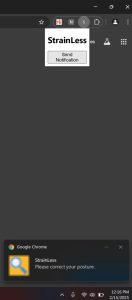What are the most significant risks that could jeopardize the success of the project? How are these risks being managed? What contingency plans are ready?
This week we received the sensors that we ordered and Kaitlyn and Lilly tested them each individually to ensure that they work. This upcoming week we are beginning to connect sensors and microcontrollers and start small amounts of integration, which if unsuccessful will be the thing that will jeopardize our project the most. These risks are being managed by slowly doing integration, i.e. one device at a time so if there is a problem then we can more easily determine where it is coming from. On the software side of things, the most significant risk at the moment is not being able to run the opencv library due to security issues with the browser extension (i.e. Chrome’s disabled running remote code in Manifest V3). A contingency plan in place and that Cora is currently exploring is running the blink detection code on a web app then having the web app communicate the data to the browser extension.
Were any changes made to the existing design of the system (requirements, block diagram, system spec, etc)? Why was this change necessary, what costs does the change incur, and how will these costs be mitigated going forward?
We do not have changes on the hardware side. For the browser extension we will likely have to slightly change the flow of data: web app will run remote code (i.e. opencv.js library) -> store data in cookie -> browser extension reads cookie -> extension displays data which is different from our original plan of having the browser extension both running our blink detection script and displaying data. This change does not incur costs but may affect latency delays which is of concern to us since we do not want there to be too significant of a delay between the time when the user exhibits poor posture/eye strain to when they actually get a notification that they are exhibiting these symptoms.
Provide an updated schedule if changes have occurred.
We do not have significant design changes thus our schedule remains the same.

